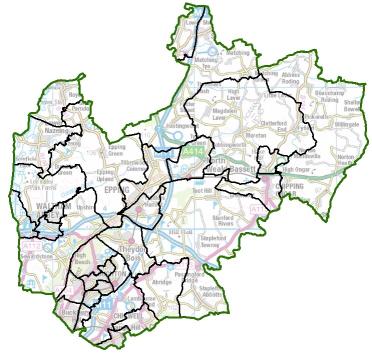Have your say on a new political map for Epping Forest District Council

A new pattern of wards is being developed for Epping Forest District Council.
The Local Government Boundary Commission has decided that the number of councillors in Epping Forest should be 54. This is a change from the current council which has 58 councillors.
The Commission wants to hear what residents and organisations think about their local area. A 10 week consultation on the proposals will run until 18 July 2022.
Current wards in Epping Forest
Click map for high resolution version
Credit: contains Ordnance Survey data (c) Crown copyright and database rights 2022
The Commission is the independent body that draws these boundaries. It is reviewing Epping Forest to make sure councillors represent about the same number of electors, and that ward arrangements help the council work effectively. It wants to be sure that its proposals reflect community ties and identities.
The Commission is interested in views on which communities should be part of the same ward. What facilities do people share, such as parks, leisure centres or schools and shopping areas? What issues do neighbouring communities face that they have in common, such as high numbers of visitors or heavy traffic? Have there been new housing or commercial developments that have changed the focus of communities? And are there roads, rivers, railways or other features that people believe form strong boundaries between neighbourhoods?
The Commission will use local views to help it draw up proposals for new ward boundaries. There will be a further round of consultation once the Commission has drawn up those proposals.
Launching the consultation Professor Colin Mellors, Chair of the Commission, said:
“We want people in Epping Forest to help us.
“We are starting to draw up new wards for Epping Forest. We want our proposals for new electoral arrangements to reflect communities. We also want them to be easy to understand and convenient for local people.
“Residents and local organisations can help us understand community ties and identities at this early stage of the process.
“It’s easy to get involved. Go to our website. Or you can e-mail or write to us.
“Just tell us what you think and give us some details why you think that. It’s really simple, so do get involved.”
The Commission has a dedicated section on its website where people can give their views.
People can also give their views by e-mail at reviews@lgbce.org.uk, and by post:
Review Officer (Epping Forest)
LGBCE
PO Box 133
Blyth
NE24 9FE
Ends/
Notes to editors:
This consultation relates to the arrangements for local government elections. It is separate from consultations that are currently taking place across England on arrangements for parliamentary elections.
For further information contact the Commission’s press office on 0330 500 1525 / 1250 or email press@lgbce.org.uk
An interactive map is available here.
The Local Government Boundary Commission for England is an independent body accountable to Parliament. It recommends fair electoral and boundary arrangements for local authorities in England. In doing so, it aims to:
• Make sure that, within an authority, each councillor represents a similar number of electors
• Create boundaries that are appropriate, and reflect community ties and identities
• Deliver reviews informed by local needs, views and circumstances

